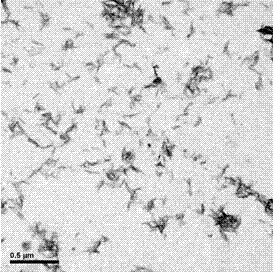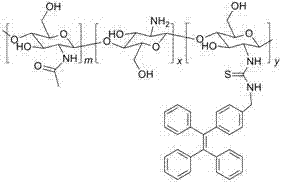Aggregation induced luminescence nanofluorescent probe and preparation method therefor
A technology of aggregation-induced luminescence and nano-fluorescence probes, which is applied in the directions of luminescent materials, chemical instruments and methods to achieve the effects of high sensitivity, good photostability, and no fluorescence spectrum drift.
- Summary
- Abstract
- Description
- Claims
- Application Information
AI Technical Summary
Problems solved by technology
Method used
Image
Examples
Embodiment 1
[0022] 1) Weigh 0.0555 g of anhydrous calcium chloride, 0.0468 g of sodium dihydrogen phosphate and 0.0294 g of trisodium citrate hydrate into a 20 mL strain bottle, add 10 mL of three-distilled water, and add 200 μL of glacial acetic acid dropwise under magnetic stirring Dissolved to make 5 mg / mL hydroxyapatite precursor solution;
[0023] 2) Dilute the hydroxyapatite precursor solution in step 1) to 1 mg / mL with triple distilled water, and add 40 wt% sodium hydroxide aqueous solution dropwise under stirring to adjust the pH of the solution to 10. At this time, the hydroxyapatite nanoparticles Precipitate, continue to stir overnight, make hydroxyapatite nano particle solution;
[0024] 3) AIE fluorescent-labeled chitosan with a labeling rate of 0.1 mol% was dissolved in 2% acetic acid aqueous solution to prepare an AIE fluorescent-labeled chitosan-acetic acid solution with a concentration of 1 mg / mL;
[0025] 4) Measure 1 mL of the hydroxyapatite nanoparticle solution prepar...
Embodiment 2
[0028] 1) Weigh 0.0555 g of anhydrous calcium chloride, 0.0468 g of sodium dihydrogen phosphate and 0.0557 g of trisodium citrate hydrate into a 20 mL strain bottle, add 10 mL of three-distilled water, and add 200 μL of glacial acetic acid dropwise under magnetic stirring Dissolved to make 5 mg / mL hydroxyapatite precursor solution;
[0029] 2) Dilute the hydroxyapatite precursor solution in step 1) to 1 mg / mL with triple distilled water, and add 40 wt% sodium hydroxide aqueous solution dropwise under stirring to adjust the pH of the solution to 10. At this time, the hydroxyapatite nanoparticles Precipitate, continue to stir overnight, make hydroxyapatite nano particle solution;
[0030] 3) AIE fluorescent-labeled chitosan with a labeling rate of 20 mol% was dissolved in 2% acetic acid aqueous solution to prepare an AIE fluorescent-labeled chitosan-acetic acid solution with a concentration of 3 mg / mL;
[0031] 4) Measure 1 mL of the hydroxyapatite nanoparticle solution prepare...
Embodiment 3
[0034] 1) Weigh 0.0555 g of anhydrous calcium chloride, 0.0468 g of sodium dihydrogen phosphate and 0.147 g of trisodium citrate hydrate into a 20 mL strain bottle, add 10 mL of three-distilled water, and add 200 μL of glacial acetic acid dropwise under magnetic stirring Dissolved to make 5 mg / mL hydroxyapatite precursor solution;
[0035] 2) Dilute the hydroxyapatite precursor solution in step 1) to 1 mg / mL with triple distilled water, and add 40 wt% sodium hydroxide aqueous solution dropwise under stirring to adjust the pH of the solution to 10. At this time, the hydroxyapatite nanoparticles Precipitate, continue to stir overnight, make hydroxyapatite nano particle solution;
[0036] 3) AIE fluorescent-labeled chitosan with a labeling rate of 10 mol% was dissolved in 2% acetic acid aqueous solution to prepare an AIE fluorescent-labeled chitosan-acetic acid solution with a concentration of 5 mg / mL;
[0037] 4) Measure 1 mL of the hydroxyapatite nanoparticle solution prepared...
PUM
| Property | Measurement | Unit |
|---|---|---|
| concentration | aaaaa | aaaaa |
| surface potential | aaaaa | aaaaa |
| surface potential | aaaaa | aaaaa |
Abstract
Description
Claims
Application Information
 Login to View More
Login to View More - R&D
- Intellectual Property
- Life Sciences
- Materials
- Tech Scout
- Unparalleled Data Quality
- Higher Quality Content
- 60% Fewer Hallucinations
Browse by: Latest US Patents, China's latest patents, Technical Efficacy Thesaurus, Application Domain, Technology Topic, Popular Technical Reports.
© 2025 PatSnap. All rights reserved.Legal|Privacy policy|Modern Slavery Act Transparency Statement|Sitemap|About US| Contact US: help@patsnap.com


